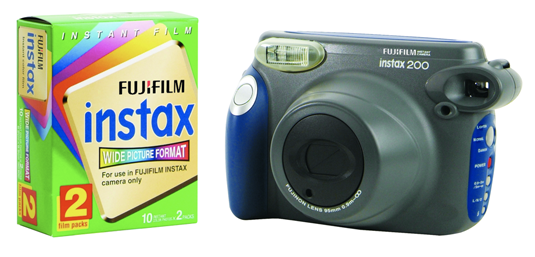 Dozens of companies that will be demonstrating their products at next week’s Consumer Electronics Show nominated themselves for the Last Gadget Standing competition. We judges whittled the contenders down to 25 semi-finalists. And now we’ve cut down that list to ten finalists who will get to show their stuff at our event at CES in Las Vegas next week. One of them will be…the last gadget standing.
Dozens of companies that will be demonstrating their products at next week’s Consumer Electronics Show nominated themselves for the Last Gadget Standing competition. We judges whittled the contenders down to 25 semi-finalists. And now we’ve cut down that list to ten finalists who will get to show their stuff at our event at CES in Las Vegas next week. One of them will be…the last gadget standing.
Tag Archives | Fujifilm
Shoot Your Own 3D
 Last Gadget Standing Nominee: Fujifilm Real 3D W3
Last Gadget Standing Nominee: Fujifilm Real 3D W3
Price: $499.99
 I’m not sure if the world is ready to start taking photos in 3D, but Fujifilm sure came up with an attractive was to do it. The FinePix Real 3D W3 digital camera is the first compact consumer 3D digital camera capable of capturing both 3D still images and HD 3D movies at 720P resolution, thanks to its dual-CCD, dual lens system. You can view 3D photos and movies on the W3’s autostereoscopic widescreen display–no glasses required–and the HDMI output port lets you connect the camera to 3D TVs. Other features include Advanced 2D Mode, which takes advantage of the dual CCD/dual lens system to capture two different 2D images at the same time–zoom and wide angle, for instance, or two different sensitivity settings.
I’m not sure if the world is ready to start taking photos in 3D, but Fujifilm sure came up with an attractive was to do it. The FinePix Real 3D W3 digital camera is the first compact consumer 3D digital camera capable of capturing both 3D still images and HD 3D movies at 720P resolution, thanks to its dual-CCD, dual lens system. You can view 3D photos and movies on the W3’s autostereoscopic widescreen display–no glasses required–and the HDMI output port lets you connect the camera to 3D TVs. Other features include Advanced 2D Mode, which takes advantage of the dual CCD/dual lens system to capture two different 2D images at the same time–zoom and wide angle, for instance, or two different sensitivity settings.
4 comments
3D Will be Ubiquitous at CES, But Will It be Good?
If you head to CES in January, make sure you pack your Emetrol along with the rest of the first-aid kit. You’ll be walking through miles of aisles of 3D TVs, PCs, and other gizmos, and it’s not likely you’ll be wearing your 3D glasses. Life is about to look very out of focus.
 Still, like any nascent technology, 3D has its rightful place amongst competitors in our Last Gadget Standing contest. 3D TVs and monitors, profilic as they are, don’t fit in your hand, so we’re not including them in this year’s LGS.
Still, like any nascent technology, 3D has its rightful place amongst competitors in our Last Gadget Standing contest. 3D TVs and monitors, profilic as they are, don’t fit in your hand, so we’re not including them in this year’s LGS.
One big topic among our LGS judges is 3D eyewear. What happens when you invite the gang over to watch the big game? Bring your own glasses? Compatibility issues? One-size-fits-all issues? There’s enthusiasm for universal glasses that cross brand lines and work with all 3D systems.
One comment
The Unexpected Return of Instant Photography
Back in February, the modern-day Polaroid company announced that it was ceasing production of instant film, thereby bringing an end to the business that made Polaroid Polaroid. It was a sad day for what was once one of the coolest consumer technologies going, and when I blogged a heartfelt tribute a lot of folks chimed in with their own memories.
Polaroid photography is, I’m sorry to say, still dead. Permanently, probably. But I’m tickled to report that instant photography is back, in the form of Fujifilm’s Instax 200 camera. Yup, a camera of the sort that takes film and spits out photos that develop as you watch.
Fuji says that its heard from police officers, real estate agents, healthcare providers, and others who have grown panicky over the dwindling supplies of Polaroid film, and so the company is rolling out the Instax in the U.S. for the first time. Fuji’s system isn’t Polaroid-compatible, but it’s very much Polaroidesque. The camera is $69.99; a 20-pack of film is $28.99. Both will be available in December.
I’m curious just what sort of cops, realtors, and doctors are still using Polaroid cameras, and whether they have rational explanations for ignoring the digital photography revolution which has been underway for a decade or so. If they’re merely hardcore luddites, that’s okay with me. But I was reminded of one virtue of instant photography recently when I had a passport photo taken: The photographer used a digital camera, and it took him ten minutes to download the photo, process it, and print it out. For all of digital photography’s profound usefulness, it’s not as instant as instant photography is.
One side note: Fuji’s Instax announcement comes just days after Japan’s Tomy announced a digital camera with a built-in photo printer. The Tomy product sounds intriguing–but it’s no more magical than the original instant camera that Polaroid founder Edwin Land released back in 1948. This is probably sacrilegious in the extreme, but I think it’s possible that Dr. Land would be happy to know that Fuji revived instant photography after Polaroid did its best to bump it off.

